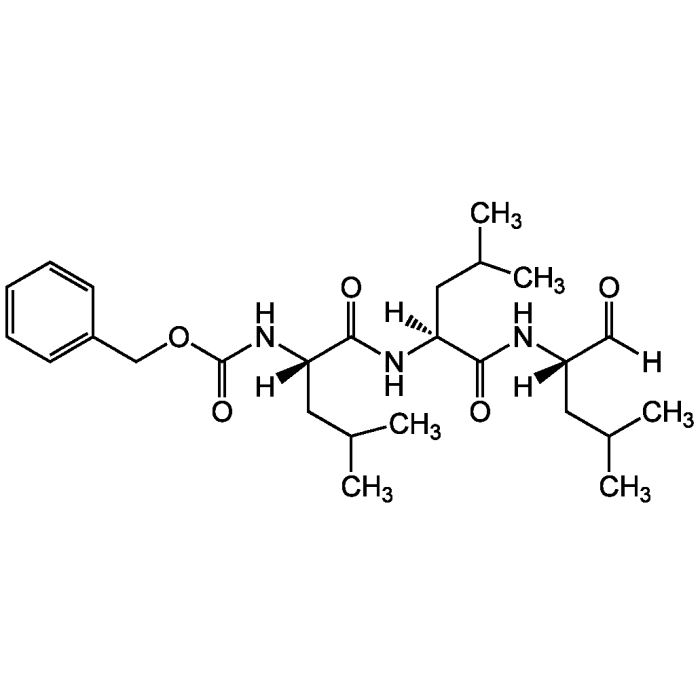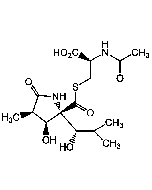Cookie Policy: This site uses cookies to improve your experience. You can find out more about our use of cookies in our Privacy Policy. By continuing to browse this site you agree to our use of cookies.
AdipoGen Life Sciences
Z-Leu-Leu-Leu-CHO [MG-132]
As low as
25
CHF
CHF 25.00
In stock
Only %1 left
AG-CP3-0011-M0011 mgCHF 25.00
AG-CP3-0011-M0055 mgCHF 65.00
AG-CP3-0011-M02525 mgCHF 195.00

| Product Details | |
|---|---|
| Synonyms | Z-LLL-CHO; Carbobenzoxy-L-leucyl-L-leucyl-L-leucinal; MG132 |
| Product Type | Chemical |
| Properties | |
| Formula |
C26H41N3O5 |
| MW | 475.6 |
| Sequence |
Z-Leu-Leu-Leu-aldeyhde |
| CAS | 133407-82-6 |
| RTECS | OH2824610 |
| Purity Chemicals | ≥97% (HPLC) |
| Appearance | White solid. |
| Solubility | Soluble in DMSO or ethanol. |
| InChi Key | TZYWCYJVHRLUCT-VABKMULXSA-N |
| Smiles | [H]C(=O)[C@]([H])(CC(C)C)NC(=O)[C@]([H])(CC(C)C)NC(=O)[C@]([H])(CC(C)C)NC(=O)OCC1=CC=CC=C1 |
| Shipping and Handling | |
| Shipping | AMBIENT |
| Short Term Storage | +4°C |
| Long Term Storage | -20°C |
| Handling Advice | Keep cool and dry. |
| Use/Stability | Stable for at least 2 years after receipt when stored at -20°C. |
| Documents | |
| MSDS |
 Download PDF Download PDF |
| Product Specification Sheet | |
| Datasheet |
 Download PDF Download PDF |
Description
- Potent, cell permeable and selective, reversible proteasome inhibitor [2, 7].
- Blocks degradation of short-lived proteins and induces a heat shock response [2, 6, 7].
- NF-κB activation inhibitor through IκB degradation [3, 8].
- Cell permeable, reversible peptide aldehyde inhibitor. Calpain and cathepsin inhibitor [4, 11].
- Has anticancer properties by inducing cell cycle arrest and activating apoptosis in various cancer cell lines [8, 9, 12,13,15].
- Has adjuvant/chemosensitizer potential [8].
- Neurite outgrowth stimulator in PC12 cells [1].
- Prevents β-secretase cleavage [5, 10].
- Autophagy activator [12, 14].
Product References
- Isolation and characterization of possible target proteins responsible for neurite outgrowth induced by a tripeptide aldehyde in PC12H cells: Y. Saito, et al.; BBRC 184, 419 (1992)
- Inhibitors of the proteasome block the degradation of most cell proteins and the generation of peptides presented on MHC class I molecules: K.L. Rock, et al.; Cell 78, 761 (1994)
- The ubiquitin-proteasome pathway is required for processing the NF-kappa B1 precursor protein and the activation of NF-kappa B: V.J. Palombella, et al.; Cell 78, 773 (1994)
- Differential inhibition of calpain and proteasome activities by peptidyl aldehydes of di-leucine and tri-leucine: S. Tsubuki, et al.; J. Biochem. 119, 572 (1996)
- The carboxyl termini of beta-amyloid peptides 1-40 and 1-42 are generated by distinct gamma-secretase activities: H. Klafki, et al.; J. Biol. Chem. 271, 28655 (1996)
- Proteasome inhibition leads to a heat-shock response, induction of endoplasmic reticulum chaperones, and thermotolerance: K.T. Bush, et al.; J. Biol. Chem. 272, 9086 (1997)
- Proteasome inhibitors: valuable new tools for cell biologists: D.H. Lee & A.L. Goldberg; Trends Cell Biol. 8, 397 (1998)
- Inhibition of NF-kappaB sensitizes human pancreatic carcinoma cells to apoptosis induced by etoposide (VP16) or doxorubicin: A. Arlt, et al.; Oncogene 20, 859 (2001)
- Potential of the proteasomal inhibitor MG-132 as an anticancer agent, alone and in combination: D. Banerjee & A. Liefshitz; Anticancer Res. 21, 3941 (2001)
- The protease inhibitor, MG132, blocks maturation of the amyloid precursor protein Swedish mutant preventing cleavage by beta-Secretase: M.L. Steinhilb, et al.; J. Biol. Chem. 276, 4476 (2001)
- The proteasome inhibitor MG132 protects against acute pancreatitis: T. Letoha, et al.; Free Radic. Biol. Med. 39, 1142 (2005)
- Induction of autophagy by proteasome inhibitor is associated with proliferative arrest in colon cancer cells: W.K. Wu, et al.; BBRC 374, 258 (2008)
- Synthesis, radiosynthesis, and biological evaluation of new proteasome inhibitors in a tumor targeting approach: M. Vivier, et al.; J. Med. Chem. 51, 1043 (2008)
- Mechanisms of cross-talk between the ubiquitin-proteasome and autophagy-lysosome systems: V.I. Korolchuk, et al.; FEBS Lett. 584, 1393 (2010)
- MG132, a proteasome inhibitor, induces apoptosis in tumor cells: N. Guo & Z. Peng; Asia Pac. J. Clin. Oncol. 9, 6 (2013)
- AQP2 Abundance is Regulated by the E3-Ligase CHIP Via HSP70: M. Centrone, et al.; Cell Physiol. Biochem. 44, 515 (2017)
- Sal-like 4 protein levels in breast cancer cells are post-translationally down-regulated by tripartite motif containing 21: J. Itou, et al.; J. Biol. Chem. 293, 6556 (2018)
- Characterization of huntingtin interactomes and their dynamic responses in living cells by proximity proteomics: H. Xu, et al.; J. Neurochem. ahead of print (2022)






